Belleville will rent 4 Automated Speed Enforcement (ASE) cameras that will be moved between the 10 Community Safety Zones (CSZs) around the City, 7 of which were added in 2023.
The program is estimated to cost $2.5 million over 5 years, with $1.5 million committed at this time and these costs are expected to be covered by the speeding tickets issued. The programs in Ottawa and Toronto are profitable and bring in millions of dollars in revenues every year.
The City had previously considered 108 resident-suggested locations for traffic calming measures as part of the 2021 Traffic Calming Pilot Project (official website page) aimed at implementing city-wide traffic calming measures, but they found that only 1 location (Village Dr) met the criteria under the City’s Traffic Calming Policy. Based on the data collected, 85% of Belleville drivers drive 10 km/h or less over the speed limit.
Now, Council is forging ahead to address residents’ speeding concerns with a new program: Automated Speed Enforcement.
When does enforcement start?
The program is to be rolled out on July 15, 2024 and the contract will remain in effect for five (5) years, until July 15, 2029.
Where are the CSZs (ASE areas)?
Before 2023, Belleville had 3 CSZ as per Community Safety Zones by-law (2008):
- Victoria Ave from Humewood Dr to Park Lane between 8AM to 5PM
- Palmer Rd from Bridge St W to Dundas St W between 8AM to 5PM
- Harder Dr from Avodale Rd to Palmer Rd between 8AM to 5PM
There are now 10 CSZs in Belleville. NOTE: Maximum speeds listed could be emergency vehicles
| CSZ Location | Collision ratio met? | Risk factor score (min 15) | Previous speed limit | New speed limit | Assessment Period 2023 | Speed limit km/h | Avg Speed km/h | Max Speed km/h |
|---|---|---|---|---|---|---|---|---|
| Victoria Avenue from Humewood Drive to Park Lane | Existing | Existing | 50 | 40 | Sept 11 to Sept 14 | 40 | 47 | 79 |
| Palmer Road from Bridge Street West to Dundas Street West | Existing | Existing | 40 | Sept 18 to Sept 22 | 40 | 46 | 92 | |
| Harder Drive from Avondale Road to Palmer Road | Existing | Existing | 40 | Sept 18 to Sept 22 | 40 | 48 | 108 | |
| Sidney Street from Moira Street West to Bridge Street West First assessment | No | 15 | 50 | 40 | Aug 15 to Aug 18 | 40 | 55 | 102 |
| Cannifton Road from College Street East to Bell Boulevard / Adam Street First assessment | Not filled in | 15 | 50 | Aug 28 to Sept 1 | 50 | 58 | 114 | |
| Sidney Street from Tracey Street to College Street West First assessment | No | 15 | 40 | Aug 15 to Aug 18 | 40 | 54 | 115 | |
| Harmony Road from Highway 37 to 449 Harmony Rd First assessment (failed) Re-assessment with new criteria | Not filled in | 13 16 | 60 | 40 | Sept 5 to Sept 8 | 40 | 60 | 109 |
| Dundas Street East from George Street to First Street First assessment (failed) Re-assessment with new criteria | No | 14 17 | 50 | Sept 11 to Sept 14 | 50 | 55 | 113 | |
| Ashley Street from Ducette Road to Old Madoc Road First assessment (failed) Re-assessment with new criteria | No | 13 15 | 50 | 40 | Sept 5 to Sept 8 | 40 | 57 | 107 |
| College Street East from North Front Street to Cannifton Road First assessment | No | 15 | 40 | Aug 28 to Sept 1 | 40 | 50 | 94 |
Notes:
- Locations that were assessed and re-assessed, but did not meet requirements both times:
- Keegan Parkway from Foster St S to Herchimer Ave – First assessment (13), re-assessment (13)
- Tracey Street from Sidney Street to North front Street – First assessment (11), re-assessment (13)
- Yeomans Street from Moira Street West to Bridge Street West – First assessment (12), re-assessment (13)
- Maximum speeds listed above could be emergency vehicles
- Average speeds include the speed of emergency vehicles – including these outliers increases the average. Using 85th percentile speed would give you an idea of the speed most non-emergency vehicles are traveling.
Notice will be posted
Belleville Council state that the public will be informed, and know where the cameras are being used. The City of Toronto provides a map showing camera locations.
Clear signage will be posted within each school zone and community safety zone where a system is in place and active. There will also be signs installed prior to the issuance of tickets to let motorists know that these systems will be installed in the near future.
Summary: Council made many changes to CSZs, allowing for Automated Speed Enforcement program expansion
In the development of this program, council has approved multiple tweaks and adjustments to the City’s Community Safety Zones policy and related by-laws over the last couple of years, making the program financially viable. They:
- Asked Staff to find additional CSZs and create a CSZ policy
- Asked Staff to change the criteria required to approve a CSZ when only 3 out of 9 suggested CSZs were approved. Additional points were then added to the assessment scores, enabling 3 more CSZs to be approved.
- Didn’t follow their own procedure outlined in the Community Safety Zone Policy when assessing and approving the new CSZs.
- Supported allowing ASE systems anywhere, not just in community safety zones
- Added 7 new CSZs, for a total of 10
- Changed the hours the CSZs are active from daytime (8PM to 5PM) to 24 hours a day
- Reduced the speed limits at 5 CSZs from 50-60 km/h down to 40 km/hr, 24/7 (not just during school times when the lights are flashing)
- Not provided or requested any data regarding existing or anticipated safety levels (eg. motor vehicle accidents/collisions) in their justification of the program. The most recent motor vehicle collision data they had available was from 2013. Instead, it is based solely on “complaints from residents”, which are often anecdotal and based on perceptions.
- Ignored findings, best practices and potential solutions outlined in the Traffic Calming Study, which found that, on average, 85% of Belleville drivers drive 10 km/h or less over the speed limit.
How much are the tickets?
The fines for speeding in a CSZ are double the normal rate and are as follows:
| km/h over the limit | Fine per km/h |
|---|---|
| 1 to 19 | $5 |
| 20 to 29 | $7.50 |
| 30 to 49 | $12 |
The total fine is made up of three components and is calculated as follows:
(1) Set Penalty Amount + (2) Victims’ Justice Fund + (3) MTO Search Fee
Here’s how much the fine would be based on driving speed:
- 10 km/h over the speed limit results in a $50 fine
- 20 km/h over the speed limit results in a $150 fine
- 30 km/h over the speed limit results in a $360 fine
The ASE threshold speed to trigger a fine is not being made public. This is standard practice across the province.
However, seeing as it costs $20 per ticket issued paid to the City of Toronto for operating costs, the threshold speed would need to be at least 4, probably 5 km/h in order for the program to pay for itself.
What is Automated Speed Enforcement (ASE)?
Automated Speed Enforcement is an automated system that uses a camera and speed measurement device to detect and capture images of license plates of the vehicles traveling in excess of the posted speed limit.
The images are reviewed by Provincial Offence Officers and tickets are issued to the owner of the vehicle, regardless of who was driving. The penalty is a fine, no demerit points are issued and the registered owners’ driving record is not effected, but it may affect your car insurance rates.
Automated Speed Enforcement is focused on reducing speeding. It’s stated benefits are freeing up police officers’ time (reducing their costs), and ensuring pedestrians and road users always feel safe by detecting speeding and enforcing speed laws on an ongoing and consistent basis.
What is a Community Safety Zone (CSZ)?
A CSZ is a stretch of road marked with CSZ signs in which speeding fines are doubled. They are set by a by-law passed by a municipal council to identify it as a road segment of higher risk or concern and where the safety of its children/citizens is paramount. CSZs are intended for:
roadways near schools, day care centres, playgrounds, parks, hospitals, senior’s residences, and may also be used for collision prone locations within a community
OTM Book 5
There is no specific warrant provided in the Ontario Traffic Manual for CSZ. However, their effectiveness depends on selective and appropriate deployment. Drivers should not encounter a CSZ in such a wide variety of applications that they lose their special designation.
The City of Hamilton, the City of Ottawa and the City of Toronto, through their own evaluation studies, have found CSZs (not including ASEs) to be generally ineffective in changing driver behaviour. Accordingly they are not currently considering additional locations for Community Safety Zones. Therefore the recommended policy should be used with great care and caution.
The Safer School Zones Act, 2017 allowed automated speed enforcement systems to be used in CSZs to address ongoing issues with speeding in school zones and CSZs.
s.205.1 of the Highway Traffic Act (HTA) states that ASE systems may only be placed in designated community safety zones and school safety zones as defined by municipal by-law. Photo radar was discontinued in Ontario in 1994.
How is a CSZ determined?
A potential CSZ is assessed by following the Checklist for Implementing and Recommendation CSZs outlined in the Community Safety Zone Policy.
Unlike Traffic Calming Pilot Project assessments, the CSZ risk assessments:
- Consider the posted speed limit, not the severity of the speeding in the area
- Uses average speed instead of 85th percentile speed (allowing emergency vehicles to increase the numbers)
- Does not take collision data into account
Here is how the two assessment forms compare:
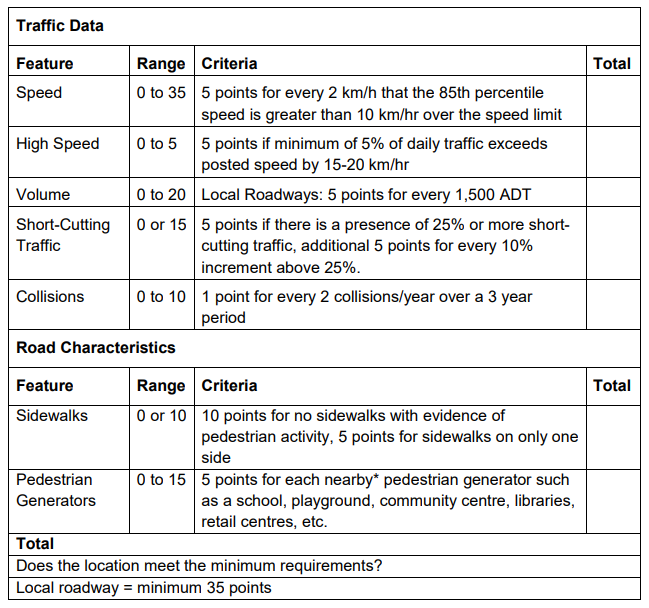
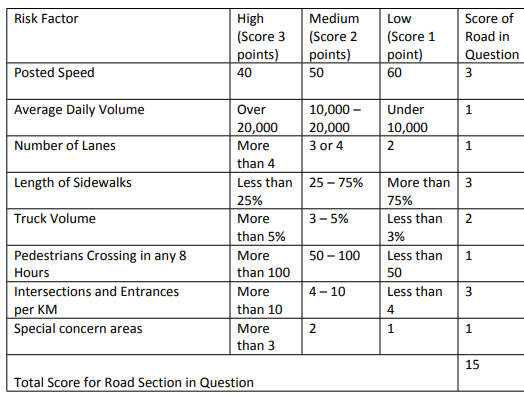
Why is ASE being implemented?
All council members agree their number one complaint from residents is about drivers speeding they also receive comments that any speed enforcement is a cash grab. They say the goal is to reduce speeding and that it is a safety issue and not a revenue-generating decision.
According to council, Belleville is experiencing issues with speeding, red light running, and aggressive driving behaviors (see: Does Belleville Have a Speeding Problem?). Council has identified a need for automated enforcement as a means to increase safety and move toward zero traffic fatalities and serious injuries. ASE provides the following positive outcomes:
- Increasing police officer safety by removing the need to pursue and conduct potentially dangerous roadside traffic stops at these intersections
- The average number of citations issued per camera decreased by 21% from active safety programs in 2019-2020. Some programs saw a decrease of 40% in violations.
- Data has shown that 92% of drivers who received a citation did not receive a second one.
- A turnkey, automated citation solution which also shows a positive ROI
What I said tonight was that in three years we make no revenue from it because no one’s speeding, we’ll all be happy, and that should be the mark of whether it’s a cash grab or not. We are not hoping to generate revenue by people speeding, we’re hoping to reduce the speeding.
Councillor Tyler Allsopp, owner of Doug’s Bikes
I have received a ticket, what are my options?
Within 15 days of receiving the notice, you must:
- Pay the fine according to the instructions outlined on the ticket.
- Request to attend court to plead not guilty and have a trial.
- Request to attend court to plead guilty and request a longer time to pay.
In 2022, a Toronto driver fought an automated ticket and won as the prosecution was unable to prove the accuracy and routine maintenance of the camera, and unable to name which company was responsible for certifying the accuracy of the camera in question, or when the camera had last been tested for accuracy. By law each device has to be calibrated within 12 months before a ticket is issued and have a Certificate of Accuracy.
For for information on options and next steps, see the Ontario ASE FAQ.
How much does an ASE system cost to operate?
The program is expected to cost approximately $500,000 per year after start-up costs.
$965,020 over 2 years for Centralized Municipal Processing Services by City of Toronto’s Joint Processing Center:

$733,612 over 5 years to rent 4 ASE cameras
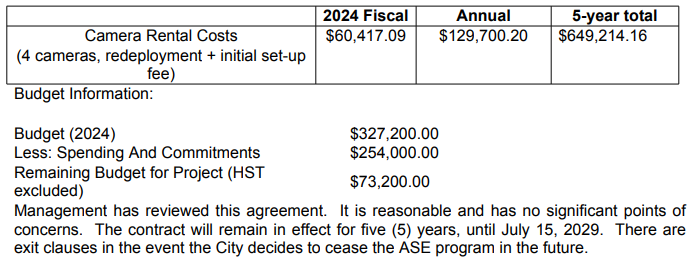
When the program is rolled out on July 15, 2024, the pricing schedule will be as follows:
- Initial camera set-up fee of $253.29 per camera;
- Daily rate for new cameras deployed at $86.37 per day, per camera.
- Redeployment fee of $75 per camera, per move; 48 total moves per year.
How much does an ASE make in revenue for the municipality?
Belleville will have 4 cameras that are movable to different CSZs around the City that are expected to charge 12 motorists per day, per camera for a total of 48 tickets issued. Using the City of Ottawa’s average revenue per ticket issued of $66, minus the $20 per ticket issued paid to the City of Toronto for operating costs, equates to $2,208 per day in revenues or $800,000 per year.
Departmental revenue in 2024 is projected to increase 9.16% thanks to increased recreation facility rentals and the introduction of automated speed enforcements fines:
Municipalities retain the net fine revenue, if any, after remittances and municipal costs. Belleville is partnering with the City of Toronto as they are the only providers of this service and are very experienced in this area. They also service; City of Ottawa, Region of Durham, City of Brampton, Region of York, and Region of Niagara.
This program will be cost neutral and net surplus (net deficit) from the Automated Speed Enforcement Program be transferred to (from) the Tax Rate Stabilization Reserve Fund to be used for traffic safety related projects/initiatives and community road safety projects.
GMTOS-2023-29
Net revenues budgeted by Hastings County for Automated Speed Enforcement have been estimated at $502,300, so it is expected that
$174,600 surplus will be transferred to the Tax Rate Stabilization Reserve fund for this initiative.
According to the Ontario Traffic Council, which promotes the use of ASE programs:
ASE isn’t about profit. …The reality is that municipalities will likely be operating at a loss in terms of the ASE program.
However, after a discussion with the ASE system’s vendor, Belleville staff reported that the solution “shows a positive ROI“.
Ottawa
Ottawa Automated Speed Enforcement Pilot reports their Automated Speed Enforcement Camera Violations statistics on their Open Data platform. The system issued 165,015 speeding tickets in the first 10 months of 2023 during which time it generated $11 million in revenue for an average speeding ticket of $66. 18 of the city’s 28 cameras have been in operation since the start of the year. The funds are to go towards the City’s Road Safety Action Plan.
Toronto
Statistics for Toronto show that in a little over 2 years, between July 2020 and November 2022, Toronto’s speed cameras issued more than 590,000 charges from 50 cameras installed throughout the city (2 per ward), relocating them every 3 to 6 months. In the same timeframe, the city collected $34 million in fines.
Each ASE device costs about $50,000 annually to operate and maintain ($2.5 million total), resulting in an estimated net proceeds of $31.5 million, not including operating costs from Transportation Services, Court Services and Legal Services. The City added 25 more systems in February 2023.
York Region/Newmarket
York Region had 5 cameras rotating throughout the community between 2021 and 2023, and intends to up the program to include 60 additional cameras between 2024 and 2026.
Newmarket collected 6,000 tickets with a value over $600,000 in the first 4 months of the program from a single camera. Additional cameras are being added to 14 local neighbourhoods in 2024 to address traffic control concerns. Staff estimated the program could bring about $2 million in net income from the program per year.
Where will the revenues go?
In Belleville, any excess funds are to be placed in the Tax Rate Stabilization Reserve Fund, which is used to reduce the sudden impact to tax or utility rates from unexpected costs in budgets, or unexpected costs arising mid-year. The Reserve Fund has been drawn down in the past several years by City Council from a balance of $10.826 million in 2021 to $2.25 million in 2023 to fund all sorts of programs, including:
- COVID-19 related relief
- $140,000 to the Welcoming Streets program
- $650,000 to lower property tax rates in 2023
- $60,800 for the two new By-Law Property Standards Officers contract positions (four months)
- $20,000 for the relocation of a utility pole on University Ave
By contrast, the City of Ottawa puts 100% of the funds towards their City’s Road Safety Action Plan.
Timeline of ASE program decisions
The Transportation Committee consists of:
- Councillor Thompson, Chair
- Councillor Carr, Ward 2
- Councillor Kelly
- Councillor Brown, Ward 2
- Robert Jakes, director of Belleville on Bikes, a not-for-profit organization promoting cycling within the City of Belleville.
- Paul Jennings
- (previous) Margaret McDougall, a cycling enthusiast
April 18, 2019 – Toronto starts its ASE program
The City of Toronto awarded the Automated Speed Enforcement Camera Rentals to Redflex Traffic Systems (Canada).
April 24, 2019 – Transportation Committee asks staff to investigate the merits and viability of an Automated Speed Enforcement Program
January 2022 – City Staff completed their investigation and issued a RFP for Automated Speed Enforcement, Red Light Camera’s and School Bus Arm Camera
June 22, 2022 – Transportation Committee directs staff to prepare a Community Safety Zone Policy and identify additional Community Safety Zone locations based on Report TC-GMTOS-2022-08.
Staff found there is not sufficient data to fully be able to rationalize that Red Light Cameras, School Bus Arm Cameras or ASE will be a cost neutral project or determine how many infractions were taking place. Report TC-GMTOS-2022-01
It was decided to cancel the RFP so that the Transportation Committee could approve a CSZ policy, also identify other CSZs, and make recommendations to Council to amend our Traffic By-law 12967 in the future.
August 8, 2022 – Council approves the 2022 Community Safety Zone Policy and eligibility criteria based on Report GMTOS-2022-25. The eligibility criteria was being used by the Region of York and the Town of Innisfil.
February 22, 2023
Staff presented assessments of 6 CSZs of which 2 are eligible and sent to Council for approval:
- Cannifton Road (QSWC) – eligible
- Tracey Street
- Sidney Street – eligible
- Keeghan Parkway
- Yeoman Street (South)
- Ashley Street (Thurlow)
Transportation Committee asks Staff to review 3 additional potential CSZs:
- Harmony Road (near the school)
- Dundas Street (George Street to First St)
- Sidney Street (Tracey Street to College Street West)
Once CSZs are established City staff will examine the feasibility of implementing Automated Speed Enforcement in the future. Report GMTOS-2023-TC-02
March 23, 2023
Staff presented assessments of 3 CSZs, of which 1 is eligible and sent to Council for approval:
- Harmony Road (near the school)
- Dundas Street (George Street to First St)
- Sidney Street (Tracey Street to College Street West) – eligible
Transportation Committee requests more current data on Motor Vehicle Collisions from Belleville Police Services Board (most recent they had was 2013).
April 27, 2023 (minutes) – Transportation Committee asks Staff to revise and review the Community Safety Zone Policy and revisit the criteria and matrix now that it had been used it to evaluate a few roads
The first draft of the Community Safety Zones Policy has a step-by-step checklist to follow when determining if a stretch of road is eligible to become a CSZ. The process is as follows:
1. Parks/Playgrounds added to Areas of Special Concern
The area must at least 1 area of concern nearby (eg. school zone, community centre, high pedestrian traffic, senior’s centre or residence) to start justifying a CSZ. If there is, you continue. If there isn’t, the area is not eligible.
In the revised policy, Staff added “Parks/Playgrounds” to the list of designated areas of special concern:
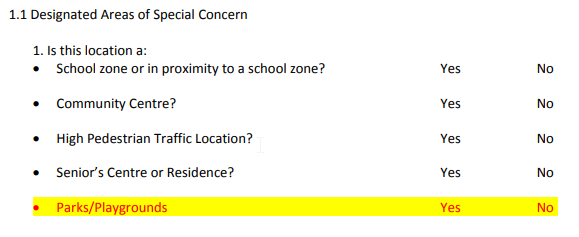
2. Staff didn’t follow their own policy when assessing potential CSZs
The next step checks if the speed limit is less than 60 km/h and the collision ratio is less than 1:900 (collisions per year to AADT) averaged over 36 months. If yes, a CSZ should be implemented. None of the CSZs in Belleville met this criterion.
When the collision ratio is not met (none of the potential CSZs met this requirement), but significant safety concerns still exist, the policy states:
Before the risk warrant for a road section can be evaluated, there must be positive confirmation from the local Police service from field observations that there is an unusually high violation rate at the location.
Community Safety Zone Policy
This is reiterated on the forms:

However, Staff did not follow their own policy:
The assessment checklists were completed in January 2023 and June 2023, before the field observations were conducted in August and September 2023, going against the process outlined in the City’s revised and approved Community Safety Zone Policy. The field observations were also done around the same time, possibly even after the 10 Community Safety Zones were installed and signed in Summer 2023.
It is unclear how the reviewer was able to complete the risk matrix without field observations, which asked for:
- Average daily volume (traffic)
- Pedestrians crossing in any 8 hours
- Length of sidewalks
- Truck volume
The lack of field observations was confirmed in my Freedom of Information request (below), which only returned the completed risk assessment matrix forms (which I already had) which had been completed after the fact, and no additional police or field observation reports.
I’m seeking a copy of any and all field observation data or reports completed for the purposes of assessing Belleville’s 10 Community Safety Zones (CSZ’s), including, but not limited to those completed as reference in the Community Safety Zone Policy, which states: “Prior to using the risk warrant matrix, field observations or the local Police services must verify that there is an unusually high violation rate at the subject location.” and as referred here: (See Attached)
Lastly, the field observations found that the average speed in each zone was anywhere from 6 km to 20 km over the 40 km/hr speed limit.
3. Additional points added to the scoring
The number of designated areas of special concern in the first section was added as a scoring category in the risk matrix, bumping up score of any potential CSZ by at least 1 additional point, all but ensuring the ones that had previously failed by 1-2 point margin, would get to the 15 point minimum to be approved.
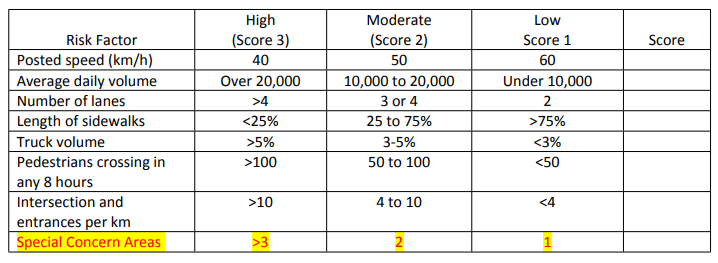
Staff strongly recommended getting input from the Police when assessing a section of road for a Community Safety Zone, warning that the City of Hamilton, the City of Ottawa and the City of Toronto, through their own evaluation studies, have found Community Safety Zones to be generally ineffective in changing driver behaviour. Accordingly they are not currently considering additional locations for Community Safety Zones. Therefore the recommended policy should be used with great care and caution.
June 1, 2023
Transportation Committee informed that maximum speeds could be emergency vehicles
Councillor Brown inquired about the one time maximum speeds that was captured in the data. It was advised that it could be an emergency vehicle and the reasoning behind focusing on the 85 percentile is because it removes the outliers that using an average would include.
Transportation Committee approves the revised Community Safety Zone Policy and refers it to Council (Revisions to the Community Safety Zone Policy)
Vendor: Belleville needs ASE to move toward zero traffic fatalities and serious injuries, solution “shows positive ROI” (ASE Program Update)
After meeting with a vendor who services other communities in Ontario and already has Joint Processing Centers in place, Staff’s notes were as follows:
- Belleville is experiencing issues with speeding, red light running, and aggressive driving behaviors.
- Existing enforcement measures are not as effective as they need to be, due to resource constraints and in some cases roadway setup.
- Council has identified a need for automated enforcement as a means to increase safety and move toward zero traffic fatalities and serious injuries.
Here are some of the positive outcomes that the vendor could provide for red light and speed solutions:
- Increasing police officer safety by removing the need to pursue and conduct potentially dangerous roadside traffic stops at these intersections.
- The average number of citations issued per camera decreased by 21% from active safety programs in 2019-2020. Some programs saw a decrease of 40% in violations.
- Data has shown that 92% of drivers who received a citation did not receive a second one.
- A turnkey, automated citation solution which also shows a positive ROI
The Committee agreed that although red light cameras are still necessary, speed cameras are the priority. Joe Reid will report back with more costing details.
June 12, 2023
Council supports Cambridge’s request to allow ASE systems everywhere, not just in CSZs and approves the 3 new CSZs (By-law 2023-110)
Moved by Councillor Kathryn Brown and seconded by Councillor Tyler Allsopp, Belleville Council supported the City of Cambridge’s request to the Government of Ontario to allow the use of ASE systems anywhere, which stated:
- Speeding on our roads is a major concern in our community
- Speeding can occur in all areas of our community
- Barriers and delays to enforcement pose a danger to our community
- Our municipality has limited resources to implement speed mitigation road design and re-design
- Our local police service has limited resources to undertake speed enforcement
City Council approved the revised CSZ policy with no recommended changes.
June 20, 2023
Staff presented re-assessments of 6 CSZs, of which 3 are eligible and sent to Council for approval (Re-evaluation of Community Safety Zones).
Staff re-reviewed locations that hadn’t met the previous CSZ criteria using the updated criteria and found 3 met criteria:
- Harmony Road (Hwy 37 to 449 Harmony Road) – eligible
- Dundas Street (George Street to First St) – eligible
- Ashely Street (Ducette to Old Madoc Rd) – eligible
- Keegan Parkway
- Tracey Street
- Yeoman Street
Transportation Committee changes CSZ by-law to apply 24/7
The hours of 6 CSZs were changed from 8AM to 5PM to 24/7 as staff feel that having a consistent approach across the municipality is prudent to keeping our all our CSZ safer. Amendment to SCHEDULE “A” To By-Law Number 2008-02 Community Safety Zones
August 14, 2023
Council approves reducing speed limit in 5 CSZs from 50-60 km/h down to 40 km/h and extends the hours to 24/7 (not just during school times).
The speeds should be consistent 24 hours per day and decrease confusion of speeds with in CSZs and the reduce the risk of tickets being challenged. (GMTOS-TAC-2023, GMTOS-2023-21)
November 14, 2023 – Council approves ASE program’s $327,200 in the 2024 Operating Budget, funded by future Speeding Enforcement Ticket Revenue

Any net surplus (net deficit) from the Automated Speed Enforcement Program be transferred to (from) the Tax Rate Stabilization Reserve Fund.
November 27, 2023 – Council approves $965,020 over 2 years for Centralized Municipal Processing Services by City of Toronto’s Joint Processing Center

The contract will remain in effect for two (2) years, until July 15, 2026, unless otherwise agreed by Toronto and the City. There are
exit clauses in the event the City decides to cease the ASE program in the future. (GMTOS-2023-31)
December 11, 2023 – Council approves $733,612 over 5 years to rent 4 ASE cameras

Rental of four (4) Automated Speed Enforcement Cameras from Redflex Traffic Systems (Canada) Limited for 5 years. There are exit clauses in the event the City decides to cease the ASE program in the future. (GMTOS-2023-33)
Early August, 2024 – Smashed glass lens housing on Victoria Avenue, knocked over camera on Harder Drive
August 11, 2024 – Speed Enforcement Cameras on Harder Dr and Sidney spray painted black
Investigations into these incidents and what the motives for defacing the cameras are continuing and anyone with information is asked to call the Belleville Police or Crime Stoppers.
August 12, 2024 – 2 cameras spray painted black
ASE reduces speeding, but does it reduce accidents?
Generally, ASE reduces speeds by about 10 km/h where speed cameras are active.
Here are some studies and reports on ASEs:
- In 2016, Quebec reported its speed enforcement program reduced average speeds by 13.3 km/h and reduced crashes by 15 to 42 per cent at ASE sites.
- Saskatchewan, which saw an overall reduction of speed in school zones (specifically in Saskatoon, Regina and Moose Jaw) following the piloting of an ASE program with 56 per cent of Saskatchewan residents wanting the program to continue and 93 per cent of those wanting it to continue, also wanting it to expand. An evaluation of the pilot also showed that average vehicle speeds fell by up to 17 per cent and speed-related casualty collisions by 63 per cent, resulting in 51 per cent fewer injuries.
- New York City, which has one of the most extensive and robust ASE programs in North America. During its 140-camera pilot program, the presence of cameras reduced speeding by 63 per cent and pedestrian injuries by 23 per cent. In 2018, the program was reinstituted.
- An evaluation of the Photo Enforcement Safety Program in the City of Winnipeg (Winnipeg Study), which indicates that speed cameras are as effective as police enforcement when it comes to issuing tickets to alter driver behaviour and reduce road traffic injuries and deaths where speed is a factor. The evaluation also analyzed the results of 35 additional studies that met its inclusion criteria and found that photo enforcement resulted in a reduction in average speed ranging from 1 to 15 per cent along with a reduction in the proportion of vehicles speeding ranging from 14 to 65 per cent.
Belleville already has a process to deal with speeding complaints
If it is determined that enforcement will not cease the speeding or other driver behaviour:
- The Belleville Police Service will inform City Staff and the Transportation Committee that speeding or other driver behavior is a concern.
- City staff will review the site to determine if a Traffic By-Law change is warranted
- If it is determined that a change to the Traffic By-Law is not warranted:
- City staff will review if the site is appropriate for traffic calming methods.
- If the site is appropriate for traffic calming methods, City staff shall inform the complainant of the next steps to install traffic calming measures.
- City staff will inform the Transportation Committee of the request and the next steps.
- If it is determined that a change to the Traffic By-Law is not warranted:
- The Committee will share the results of the review and their recommendation to Council for their consideration.
- If the change is approved by Council, a by-law, if required, will be prepared to implement the regulation
- After the by-law to implement the regulation is passed by Council, corresponding signage, if required, will be installed at the location.
- A traffic sign can take 3 to 8 weeks to install after it has been approved.
Example: How Cannifton Road North is investigated under the Traffic Calming Policy
Alternative solutions & policies
Discussions about this program in this Reddit post suggested several alternative methods of reducing speeding, and ultimately improving safety:
Lower the speed limits
People typically drive about 10 over the speed limit on average, so reducing the speed limits from 50 km/h to 40 km/h would likely reduce the 85th percentile speed from 60 km/h to 50 km/h.
Traffic calming
As mentioned earlier in this post, traffic calming measures such as speed bumps, rumble strips and medians could be installed to slow traffic in residential areas to improve safety for motorists, pedestrians and cyclists.
Traffic light programming
Belleville could use synchronized traffic lights:
Sidewalks and crosswalks
Regarding the pedestrian traffic along Sidney St on the west side by Our Lady of Fatima, a sidewalk and crosswalk was suggested:
Open Council commentary
Ensuring the law and reducing speeding are good goals.
My concern is how Council went about implementing the program, specifically how the policies and laws were adjusted, and how staff did not follow the City’s own policy in developing the program, making the program revenue neutral/profitable and therefore viable.
Claiming the program is about “reducing speeding” and “improving safety” without providing any data on road safety in Belleville to back it up – specifically collision, injury and/or fatality statistics – and ignoring the speeding data and best practices in the Traffic Calming Pilot Project results, is not good policy-making.
Council states that their number one complaint from residents is about drivers speeding and that the ASE program is being implemented to reduce speeding and improve safety, not to increase City revenues.
However, the City chose not to implement an initial proposal that “would not be guaranteed revenue neutral” and made quite a few changes to the CSZ Policy, expanding the number of areas the ASE program could be applied, seemingly to “move the goal posts” enough in order to push it through.
The ASE program will effectively shift some of the tax burden from property owners to drivers (made up of owners, renters and visitors).
In addition, my concern is that Council and staff aren’t spending more of their time and energy on more pressing issues.

Questions outstanding
- What will the costs be to remove spray paint from the cameras and have police monitor the cameras to prevent/identify vandalism? In Toronto, they make so much money that they have companies that clean them regularly.
- Can traffic and speed cameras be subpoenaed?
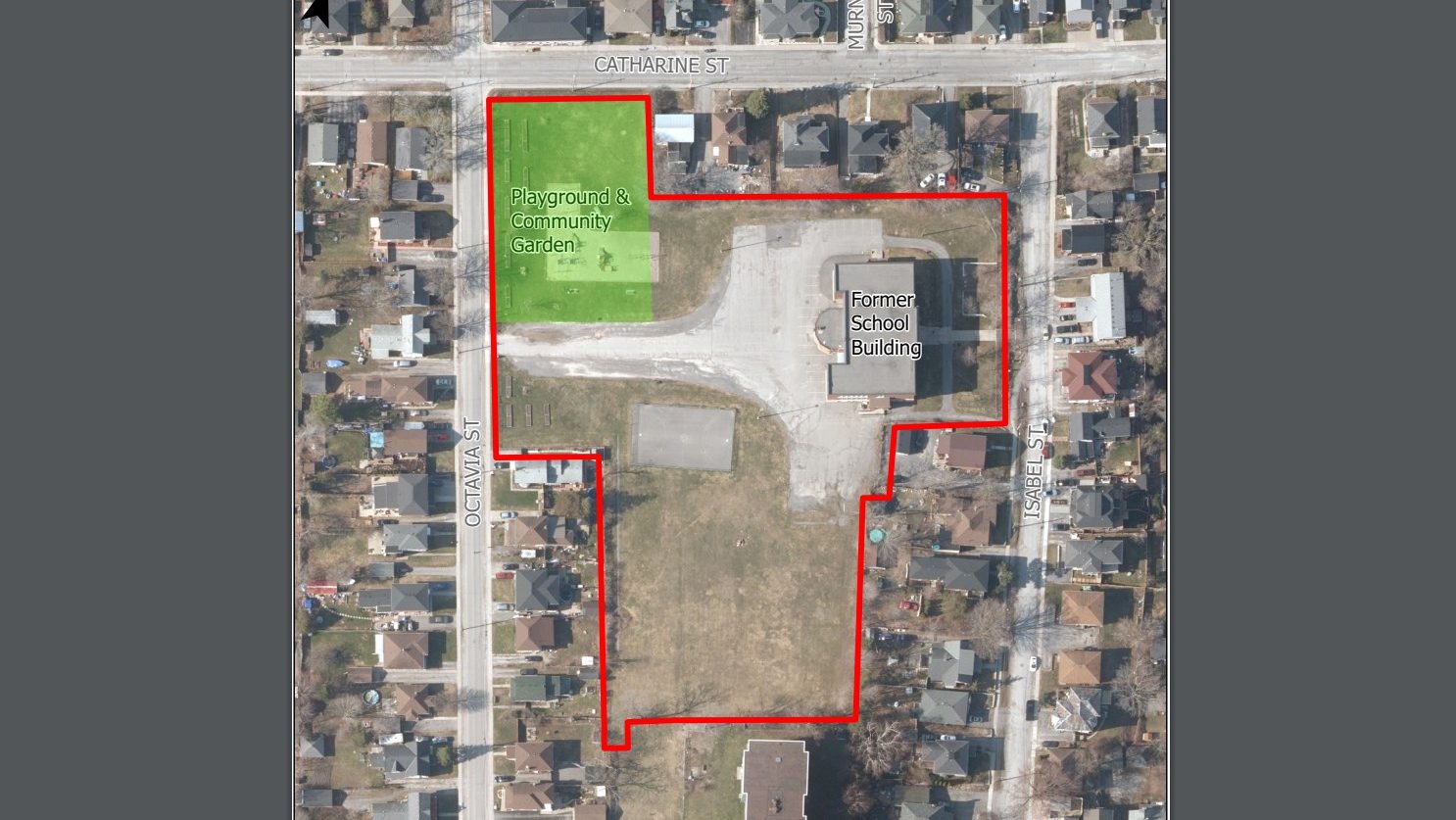

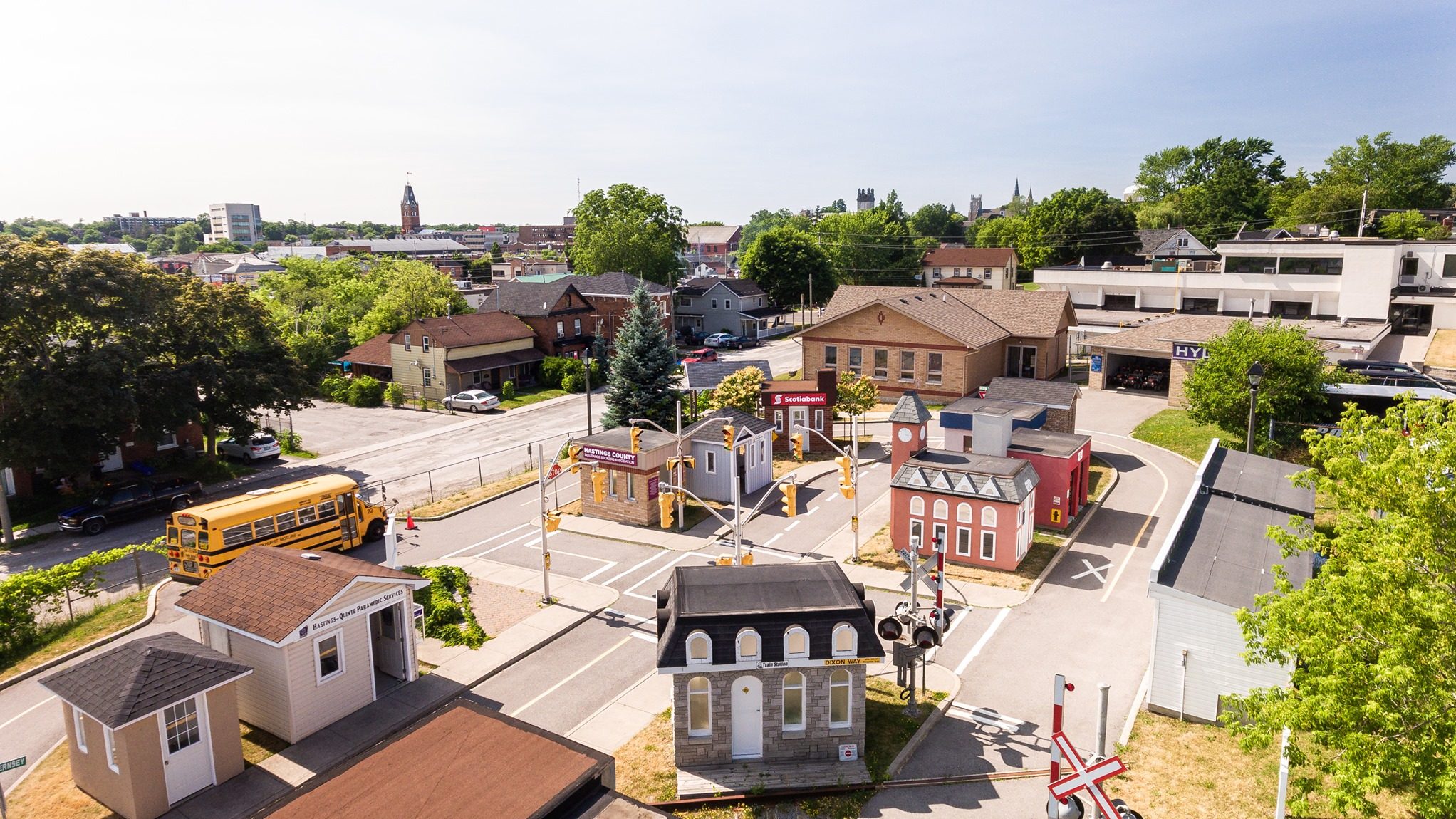
Comments
We want to hear from you! Share your opinions below and remember to keep it respectful. Please read our Community Guidelines before participating.